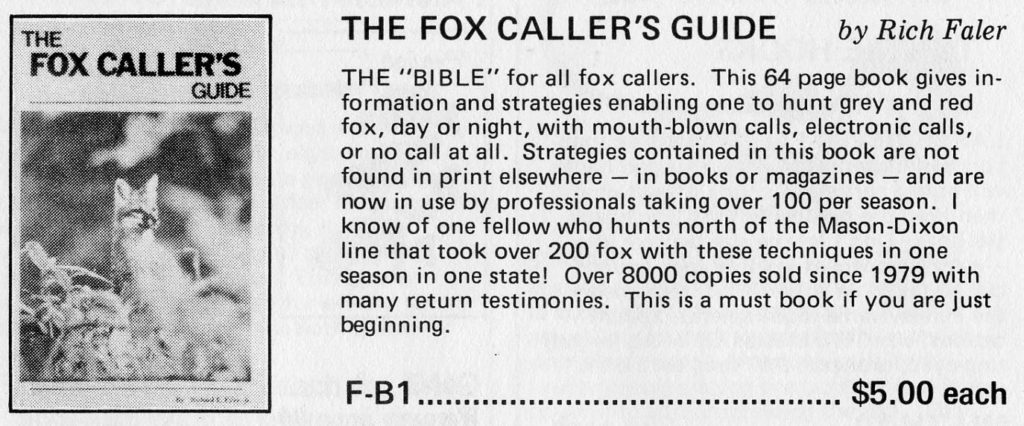
Most my books are how-to-do topics which I promote in vertical market niches. In other words, I send press releases and purchase ads in specialty magazines on that topic. A case in point is the very first book I wrote and self-published, “The Fox Caller’s Guide”.
Written in 1978, I placed ads for “The Fox Caller’s Guide” in six magazines. The most notable were Fur-Fish-Game and The Trapper magazines. The Trapper was a newsprint tabloid with very low rates. Fur-Fish-Game had coated stock and was a regular magazine format. It was, for me, very pricey, but still a good fit for a book on fox hunting. Knowing well in advance that I’d be advertising in these magazines and others with sometimes small black-and-white ads, I selected a cover for the book with that very thought in mind.
My original cover for this book was a close-up of a gray fox taken one summer morning. Driving down Creek Road across the Little Shenango River from my house, I saw a gray fox rolling on the asphalt road – just as a cat does on a warm road. As I drove closer, another fox and the original “roller” ran off into the woods. Fortunately, I had my camera, my electronic game caller, and time. I parked just short of where the fox had been cozying on the road. I stepped down into the ditch and hunkered down against the ditch’s lower far side. I got the 35mm camera ready and turned on the game caller.
In a couple short minutes, one of those gray fox ran back onto the road and directly in front of me. I snapped the shot of him as he peered down toward the source of the caller’s squawking. That shot was black-and-white, but perfect for the future ads. It made for a very successful launch and sustained sales for “The Fox Caller’s Guide”. I sold over 5,000 copies of the book the first 1985-86 winter season – and these were direct, individual sales, the most profitable of all!
A beautiful cover is what we all want on our book. But do not get so carried away with the artistic details that future sales may be impacted. A beautiful book in hand, or on a bookstore shelf, may not be the ideal for certain types of advertising where size and even color are necessarily modified. Some cover designs have multiple photos and/or art which become a non-descript clutter when reduced to a thumbnail in ad copy. Likewise, the title itself may be thin type and with a color which blends into the art rather than stands out. A thumbnail-sized cover in your ad just won’t pop or convey enough information – it an be wasted effort.

A catalog sold “The Fox Caller’s Guide” and a competitor’s “Professional Predator Calling”. The catalog listing for each book is with this article. Technically the photo on “Professional Predator Calling” was a grade above that of “The Fox Caller’s Guide”. The “Professional Predator Calling” cover was a full-color photo of a striking bobcat. It was beautiful. Conversely, “The Fox Caller’s Guide” cover had a photo with a soft focus, not tack sharp. It was in black-and-white which in this day and age is boring. The cover was serviceable for the market. Now compare the grade A and grade B covers as reproduced in black-and-white thumbnails. Which one stands out and conveys the most info? It’s “The Fox Caller’s Guide”. The bobcat in the other book is hard to see and the title is lost. These two covers show how it takes more than an otherwise great cover to do the job in certain advertising and promotional avenues.
When designing a cover for a how-to-do book, I want one large photo or piece of art which is easily identified with the book’s main topic. I also want a photo/art which pops. I want thick type that stands out for the title. I don’t worry about the author’s name or a subtitle being readable when the cover is reduced for an ad, but the title certainly must.
I am aware of no hard fast rule on cover design in respect to advertising. That being said, I recommend every book cover be viewed with an eye to all possibilities of promotion and sales. If small thumbnails are definitely in the mix, take that into consideration before the final cover is approved. It is important – and can result in many more copies being sold! •
